How and when to open thuja after winter?
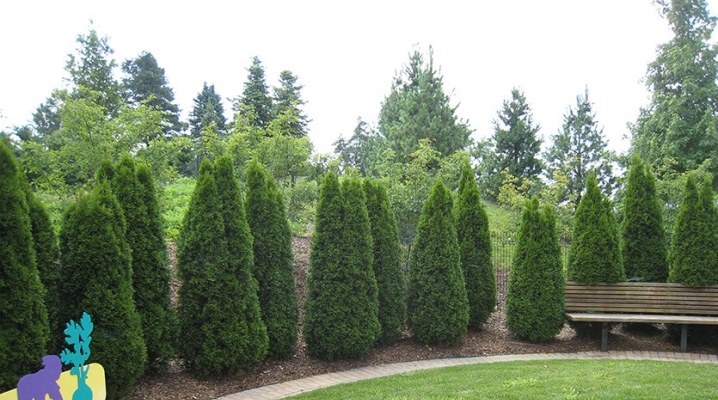
Ornamental gardening is represented by many types of plants, but thuja is especially popular among landscape designers. This evergreen shrub can reach various heights, and thanks to the dense needles with a scaly structure, it can be given original shapes. To grow thuja at home, you need to make a lot of effort, while special attention should be paid to preparing the tree for wintering and timely removal of the protective shelter in the spring.

Peculiarities
Thuja is one of the most beautiful coniferous trees, which not only gives the backyard an attractive look, but also freshens the air well. Therefore, many plant this shrub in their dachas. The first few years after planting, the culture is especially demanding to care for. To keep it from freezing in winter, gardeners cover it in a special way. Then, in the spring, the tree must be freed from protection, removing the covering material. This must be done correctly, otherwise a thuja that has successfully survived the winter can immediately die from the first scorching rays of the sun.
The first year after disembarkation, it is recommended to insulate the thuyu well. To further prevent freezing of the root system, you need to carry out abundant mulching. The branches are neatly tied to the trunk and everything is wrapped in a special covering material that allows light to pass through. If the shrub is hidden under a shelter that does not let the rays of the sun go, then the plant will disrupt the process of photosynthesis, which will lead to death.
After the tree has successfully overwintered, the most important thing is to prepare it for the first spring sunbeams. The peculiarity of this procedure is that it must be carried out slowly, observing the basic rules. It is impossible to immediately remove the shelter with warming, the thuja in this case can suffer greatly - dry out, turn yellow or get burns.
Experts recommend, after removing the covering material, to put additional shields that shade the coniferous plant.

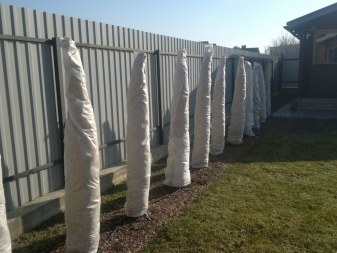
Timing
Thuja should be opened after winter, regardless of their varietal characteristics, in the spring, when the snow has completely melted from the ground. At the same time, in the Moscow region, trees can be opened after winter shelters immediately with the onset of warming, but in the Urals and Siberia, wrapped crops can be opened only after warming up the soil... In these regions, you cannot remove the shelter after the first rays of the sun appear, as they will cause significant damage to the tree.
After wintering, the plant is weakened and can quickly die from the sultry sun. So, for example, in Siberia, coniferous crops, when they receive spring burns, lose their decorative effect, so if you hurry and quickly open them, you can permanently lose the "hedge" in the garden.
Experienced gardeners usually open thuja after their root system is fully awakened. This can be determined by the appearance of the first swollen buds on bushes and deciduous trees. It is especially important to monitor the condition of the thuja after wintering for the first 2-3 years, since at this time it can turn yellow, shed the needles and dry out. It is advisable to open young plantings gradually, increasing the time every day. This will allow the tree to adapt to new climatic conditions.
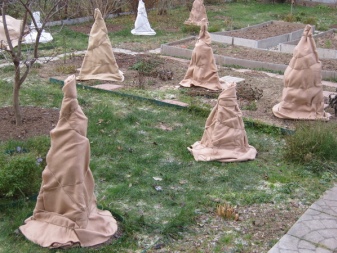
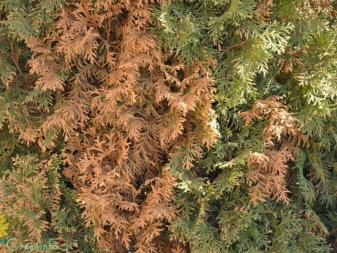
Follow-up care
Thuja should be watered abundantly after opening in the spring.This is due to the fact that under the influence of the first rays of the sun, the shrub will begin to actively grow and develop, so the root system will need a lot of moisture. Watering is best done in the morning or in the evening (the first 10 days, the seedlings are watered twice a day). In addition, sprinkling (spraying) of the crop should be carried out once a week. In the spring, after removing the covering material, the thuja should also be provided with the following care.
- Mulching. This will prevent the soil from drying out near the root circle, which is covered with peat, spruce branches and sawdust. In winter, mulch protects the plant from frost, and in summer - from the sultry sun.
- Loosening the soil. Periodically, around the tree, it is necessary to loosen the soil to a depth of 10 cm - this will contribute to better growth and development of the plant.
- Top dressing. It is recommended to fertilize ornamental crops twice a year: in spring and at the end of summer. This period usually lasts from early May to late August. Thuja can be fed with various trace elements. But it is advisable to purchase fungicidal preparations and complex fertilizers intended for coniferous crops.
- Pruning. After the thuja is opened, it is important to timely prune diseased, old and dry branches. Thanks to this, the tree will be able to renew itself with new shoots and begin to grow faster. Decorative pruning can also help shape your crop.
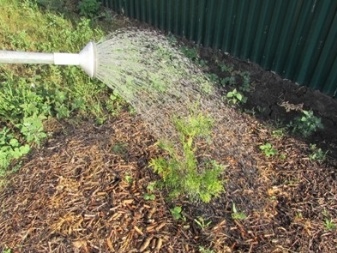
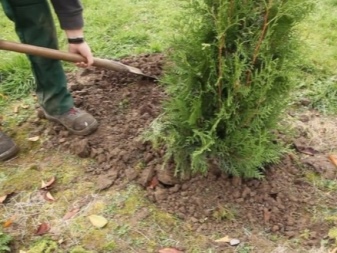
In addition, in the spring it is necessary to carry out preventive measures aimed at protecting plants from diseases and the appearance of insects. Most often, ornamental shrubs are sprayed with preparations containing copper; Bordeaux liquid is also well suited. Spraying should preferably be done after sanitary pruning.
If old, rotten, dead and fungal plants are found in the garden in the spring, they are removed, and the stumps are uprooted and burned.
Possible problems
Each summer resident wants to see his site lively in the spring, and in this case, the evergreen beauties-thuja point to signs of awakening. But sometimes it happens that after winter you can expect disappointment - ornamental shrubs have died or turned yellow.
There can be many reasons for this. For example, a tree changes its green color to an unnatural shade (bronze, golden) on its own when the seasons change. If in the spring the thuja not only turned yellow, but also acquired a depressed appearance, became dry and fragile, then this is a serious signal indicating that urgent action is needed. To begin with, you should perform sanitary pruning and apply nitrogen fertilizers.


Often after winter, shrubs turn yellow due to improper care. If an inexperienced gardener opens the thuja too early after wintering, then it can get sunburn, after which it will die. To prevent this, after removing the covering material next to the thuja, you need to install special shields that shade the plant.
A bronze tint on the needles appears in the spring due to the fact that the tree experienced a lack of moisture in the fall. As a result, the plant “went to winter” unprepared, and with the onset of heat it is difficult for it to regain strength and start active growth.
A special irrigation regime, pruning of damaged branches and fertilization will help to restore the former beauty to the shrub.
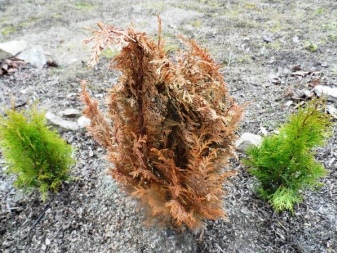

In some cases, thuja may turn black after winter, the most common reason for this is animal feces. Those areas of the needles, where the urine of cats and dogs gets, begin to darken quickly. At first, small dark spots appear, located chaotically, then they merge into one large spot.
If this is not replaced in a timely manner, then the defeat will become extensive, and the tree will not be able to be saved in the future. With small lesions, the branches are cleaned with water, then fences are installed near the plantings, restricting the access of animals to the thujas, and feeding with a growth stimulator is performed.
The next video tells you when to take cover from conifers.



































































The comment was sent successfully.